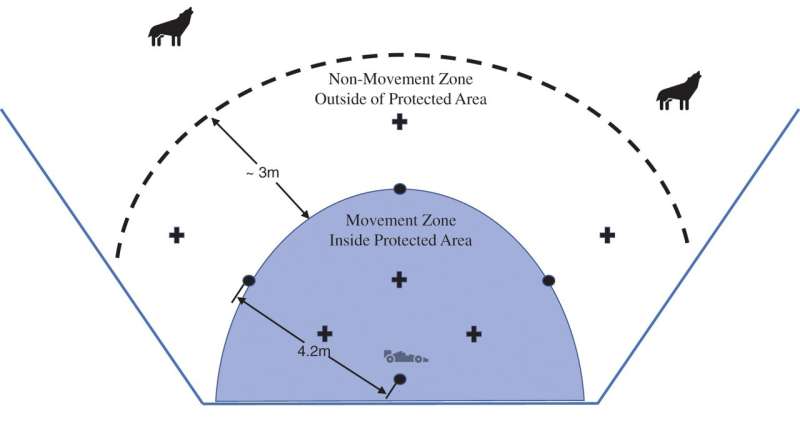This article has been reviewed according to Science X's editorial process and policies. Editors have highlighted the following attributes while ensuring the content's credibility:
fact-checked
peer-reviewed publication
trusted source
proofread
Integrating robotics into wildlife conservation: Enhancing predator deterrents through innovative movement strategies

The coexistence of wildlife and agricultural practices has long posed challenges for wildlife conservation, especially when conflicts arise. Livestock predation is a prime example of such conflicts, requiring effective management strategies that minimize human-wildlife conflict while preserving valuable agricultural resources.
A new study published in PeerJ, titled "Integrating Robotics into Wildlife Conservation: Testing Improvements to Predator Deterrents through Movement," explores the integration of robotics and agricultural practices to develop more efficient predator deterrents.
The study capitalized on the concepts of robotics, specifically automated movement and adaptiveness, to enhance the effectiveness of predator deterrents. The researchers employed a model system using a colony of captive coyotes and simulated predation events with meat baits both inside and outside of protected zones. Inside the protected zones, the researchers utilized a cutting-edge, commercially available predator deterrent called the Foxlight, mounted on a remote-controlled vehicle.
The study tested three deterrents: (1) light only, without movement or adaptiveness; (2) predetermined movement, with movement but without adaptiveness; and (3) adaptive movement, incorporating both movement and adaptiveness.
The survival of the baited meat was consistently higher inside the protected zones, and the three movement treatments demonstrated incremental improvements in survival time compared to the baseline, except for the light-only treatment in the non-protected zone. Incorporating predetermined movement effectively doubled the efficacy of the light-only treatment, both inside and outside the protected zone. Furthermore, the incorporation of adaptive movement exponentially increased the survival time of the baits, regardless of their location.
The findings of this study provide compelling evidence that integrating existing robotics capabilities, such as predetermined and adaptive movement, can significantly enhance the protection of agricultural resources and contribute to the development of nonlethal tools for managing wildlife. Moreover, the research emphasizes the importance of combining agricultural practices, such as spatial management of livestock at night, with innovative technologies to improve the efficacy of wildlife deterrents.
The study's findings have significant implications for wildlife conservation, as they highlight the importance of embracing technological advancements to address human-wildlife conflicts. The integration of robotics into agricultural practices offers a promising path towards sustainable coexistence and the preservation of biodiversity.
More information: Stewart W. Breck et al, Integrating robotics into wildlife conservation: testing improvements to predator deterrents through movement, PeerJ (2023). DOI: 10.7717/peerj.15491
Journal information: PeerJ
Provided by PeerJ




















